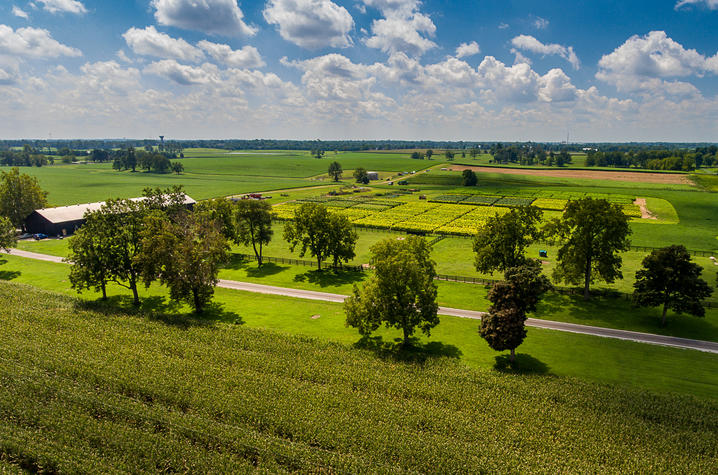Despite COVID-19, Kentucky Agricultural Receipts Hold Steady to 2019 Levels

LEXINGTON, Ky. (Dec. 4, 2020) — The COVID-19 pandemic made for a tumultuous year in Kentucky agriculture, but the state’s agricultural receipts will likely hold steady to 2019 levels.
Agricultural economists from the University of Kentucky College of Agriculture, Food and Environment are projecting 2020 farm cash receipts to be $5.5 billion, equaling 2019 receipts. The economists estimate that net farm income will likely exceed the $2.2 billion Kentucky producers earned in 2019.
“Like most businesses, agriculture has experienced a crazy and challenging year, but unlike a lot of industries, the farm economy not only survived, but is ending 2020 on a positive note,” said Will Snell, UK agricultural economist.
Snell and fellow UK agricultural economists Kenny Burdine, Greg Halich and Tim Woods, Jerry Pierce from the Kentucky Farm Business Management Program, and Bobby Ammerman from UK’s Department of Forestry and Natural Resources shared their annual outlook with Kentucky Farm Bureau members.
2020 began with optimism across the industry due to new trade deals, continued low production costs and improved supply/demand balances. But the coronavirus greatly impacted the industry and the agricultural markets. While markets initially plummeted at the pandemic’s onset, some sectors recovered.
In Kentucky, higher grain prices, induced primarily by an increase in exports, and crop yields near all-time highs helped offset lower equine, poultry, cattle, dairy and tobacco receipts.
“The increase in grain prices along with outstanding yields could help make 2020 the most profitable year for grain producers since 2013,” Halich said.
“The impacts of COVID on the livestock sector were huge, as labor challenges created a significant processing bottleneck in the spring and the marketing system had to adjust to a major shift away from restaurant consumption and toward at-home consumption,” Burdine said.
A significant addition to Kentucky’s increased farm income is two rounds of government payments producers received through the Coronavirus Food Assistance Program and the last payments from the 2019 Market Facilitation Program. Accounting for these and other federal programs, Kentucky farmers may receive close to $500 million in direct government payments in 2020.
Nationally, direct government payments may account for nearly 40% of the country’s net farm income. The U.S. Department of Agriculture forecasts net farm income will be $119.6 billion, up 43% from 2019.
“Despite an expected increase in net farm income and potential for improved commodity prices in 2021, the national and Kentucky farm economies remain very vulnerable, especially if the ag sector experiences large crops, additional trade disruptions, a significant pullback in direct government payments, higher interest rates, and/or a decline in asset values,” Snell said.
Poultry remains Kentucky’s top agricultural commodity, comprising 19% of all projected sales for the year. Corn and soybeans tied for second, each accounting for 17% of all projected sales. Equine fell to fourth, with 16% of all projected sales.
Highlights from selected commodities are:
- Poultry — Markets were adversely impacted by COVID-19 with wholesale broiler prices down 20% in 2020. While most poultry growers were not directly impacted by broiler prices, many were indirectly impacted by increased time between flocks. However, the industry remains relatively stable, and 2021 is likely to be much improved.
- Corn — Exports are expected to see a significant increase during the 2020-2021 marketing year, which could push on-farm prices up to $4 a bushel.
- Soybeans — Exports are expected to increase 14% above the five-year average. This should push on-farm prices to $10.40 a bushel.
- Equine — After surpassing $1 billion in 2018 and 2019, receipts are expected to drop considerably in 2020 given a sharp sales decline. Another decrease is likely for 2021 as both stud fees and the number of mares bred should decrease.
- Cattle — COVID-19 impacts on demand and supply chain disruptions rocked the markets, especially in the spring and summer. Assuming COVID-19 impacts lessen in 2021, demand should improve. The demand increase and a smaller calf crop should increase prices next year.
- Hemp — Production dropped significantly from 2019 record highs. Licensed acreage was down by nearly half from 2019. Low price expectations, unsold stocks, minimal infrastructure development and market and regulatory uncertainties will keep acreage down in 2021.
- Tobacco — The sector continued to shrink with acreage down 10% to 15% and variable yields reported. Despite higher prices, receipts are expected to drop $30 million to $40 million from 2019.
- Produce and Nursery — While early for a 2020 estimate, total produce and nursery receipts are expected to reach $160 million, which is a state record. CSAs, agritourism, produce auctions and garden center nursery sales are expected to be up significantly.
- Forestry — The sector contributed $12.9 billion to Kentucky’s economy in 2020 with timber and lumber prices improving from 2018-2019 levels. UK foresters expect this contribution to remain steady with stumpage values continuing to improve. Going into 2021, concerns exist for logging capacity, the long-term health of small sawmills and the lack of markets for low-grade pulpwood in Kentucky.
For the entire outlook, visit the UK Department of Agricultural Economics website at https://agecon.ca.uky.edu/2020-2021-economic-situation-outlook or visit their Facebook, Twitter and YouTube accounts @UKYAgEcon.
As the state’s flagship, land-grant institution, the University of Kentucky exists to advance the Commonwealth. We do that by preparing the next generation of leaders — placing students at the heart of everything we do — and transforming the lives of Kentuckians through education, research and creative work, service and health care. We pride ourselves on being a catalyst for breakthroughs and a force for healing, a place where ingenuity unfolds. It's all made possible by our people — visionaries, disruptors and pioneers — who make up 200 academic programs, a $476.5 million research and development enterprise and a world-class medical center, all on one campus.




